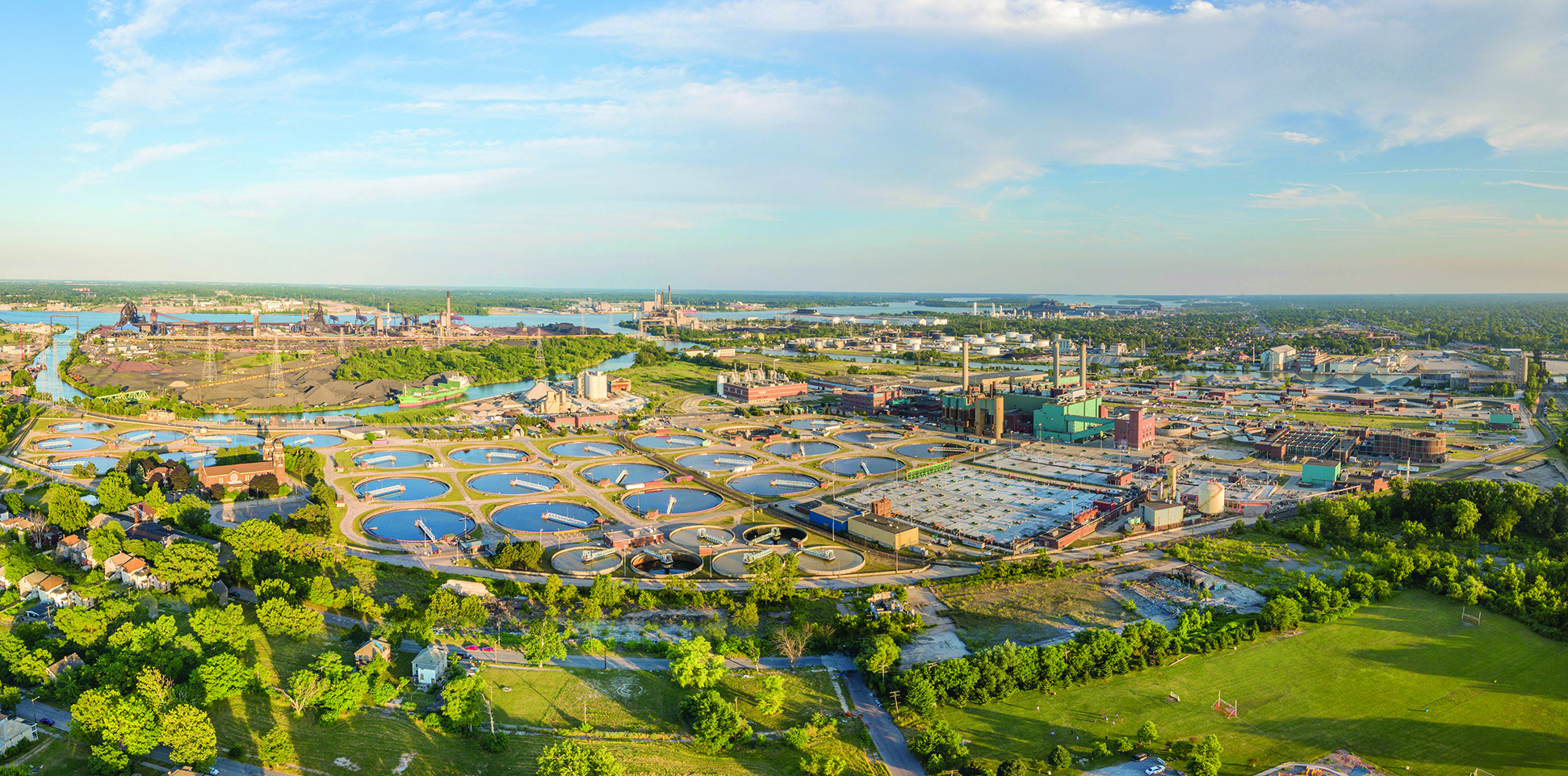Three agencies charged with collecting wastewater in southeast Michigan are teaming up as part of a unique collaboration aimed at reducing sewer overflows to the Rouge River, a tributary of the Detroit River that has been identified as an Area of Concern within the Great Lakes watershed by the U.S. Environmental Protection Agency. By working together, the Great Lakes Water Authority, the Detroit Water and Sewerage Department, and the Water Resources Commissioner of Oakland County, Michigan, will reduce overflows into the river faster and for less expense than if they each acted individually.
As a provider of drinking water and services pertaining to wastewater treatment for much of southeast Michigan, the GLWA treats the influent from nearly 80 communities. The DWSD maintains nearly 3,000 mi of sewer within the Detroit city limits. The WRC oversees certain stormwater drains, operates several wastewater treatment facilities and community septic systems, and maintains all county-owned sewers within Oakland County.
Planning for a regional approach
In December 2020, the GLWA approved its Wastewater Master Plan, outlining the authority’s strategy through 2060 for managing its regional wastewater system. This system includes 195 mi of trunk sewers and interceptors as well as its massive 1,700 mgd Water Resource Recovery Facility, which the GLWA says is the largest single-site treatment facility in North America.

“The recently adopted 40-year Wastewater Master Plan was created to proactively and adaptively manage the wastewater system that serves 2.8 million people and spans 15,000 miles of pipes across 79 communities in southeast Michigan,” says Suzanne Coffey, P.E., the chief planning officer for the GLWA. Developed in partnership with numerous stakeholders, including the DWSD and Oakland County’s WRC, the Wastewater Master Plan aims to facilitate regional collaboration and optimize wastewater improvements among participating agencies.
Significant financial needs prompted the collaborative approach, Coffey notes. “The Wastewater Master Plan estimates that over $1 billion more in investment is needed in the regional system and close to another $1 billion in the member partners’ systems,” she says. “This large investment is why the plan is purposefully focused on collaborating, adapting, and watching for opportunities to gain economies of scale and leverage work already being done for the greater benefit of the region. This approach seeks to find more cost-effective solutions so as not to have to invest at this level.”
Announced by the GLWA in February, the first collaborative effort to be conducted as part of the Wastewater Master Plan involves a regional approach to reducing sewer overflows into the Rouge River. To this end, the GLWA, the DWSD, and the Evergreen-Farmington Sanitary Drain Drainage District — an entity under the purview of the Oakland County WRC — will implement collection system improvements to benefit local water quality for less cost than if each acted on its own.
Saving on added sewer capacity
The sanitary sewer system of the Evergreen-Farmington Sanitary Drain Drainage District is most prone to overflows during late winter and early spring, particularly when rainfall occurs on top of snow cover, says Carrie Cox, P.E., the chief engineer overseeing capital asset management and planning, mapping, and sewer metering for the WRC. The district’s sewer system is “really susceptible to snowmelt and wet ground,” Cox says. “Our sanitary sewer overflows typically occur in February and March.”
Under the terms of an administrative consent order from the state of Michigan, the district must eliminate sanitary sewer overflows during the design storm, which is defined as a 10-year, one-hour storm event that occurs during the nongrowing season. Originally, the district expected to have to construct a wet-weather storage tank ranging in capacity from 10 million to 13 million gal. and an associated pump station to accommodate excess flows in its collection system, Cox says. Simply constructing the storage tank would have cost $80 million, not to mention expenses pertaining to operation and maintenance. “It was a pretty expensive alternative,” she notes.
Thanks to the regional partnership with the GLWA and the DWSD, the district has another alternative, one that costs less and delivers more environmental benefit. Instead of constructing the storage tank, the district is paying for a sewer separation project in Detroit that will free up capacity in the regional collection system that conveys flows to the GLWA’s Water Resource Recovery Facility. Upon completion, the sewer separation project will increase the district’s sewer capacity from 170 to 227 cfs, Cox says.
Although the precise amount to be paid remains under negotiation, the district expects to pay on the order of $32.1 million toward the cost of the Detroit project, Cox says. Meanwhile, the district likely will have to spend between $20 million and $30 million on hydraulic capacity improvements to its own system. Even so, the district will come out far ahead financially as a result of the collaboration, she notes. “We think overall we’ll save $10 (million) to $15 million over a 20-year period,” Cox says.
Expediting improvements
In Detroit, the DWSD will use the funding from Oakland County to expedite the completion of its Far West Detroit Stormwater Improvement Project, a $38 million effort to create a “new drainage system within a 1,300-home neighborhood along the Rouge River,” says Palencia Mobley, P.E., M.ASCE, the department’s deputy director and chief engineer. As a result of the project, runoff that currently enters the local combined sewer system will be directed instead to “natural stormwater channels and basins within Rouge Park, which sits immediately east of the neighborhood,” Mobley says. In this way, combined sewer overflows, basement backups, and street flooding will be reduced in the area.

Scheduled to begin this summer, construction of the Far West project will include 25,000 ft of storm sewer, two stormwater detention and water quality basins, trails, and prairie and woodland habitat restoration within Rouge Park. “While work occurs on the storm sewer, the existing water and sewer systems within the neighborhood will be upgraded along with lead service line replacement,” Mobley says.
Along with treating stormwater discharges before they enter the Rouge River, the project will improve conditions within the waterway by eliminating combined sewer overflows “during the 10-year, 24-hour-recurrence-interval rain or snow event,” Mobley says. This outcome “removes approximately 4.3 million gal. of untreated sewage” per design event, she notes.
As a result of the regional collaboration, the DWSD will be able to deliver the Far West project “at a lower cost and more quickly,” Mobley says. “The use of a regionwide sewer model and master plan identified that overflows could be more cost-effectively mitigated through funding the Far West project,” she says.
More savings
As for the GLWA, it will expedite improvements designed to reduce overflows from its West Warren combined sewer outfall in Detroit. Scheduled to begin following the completion of the DWSD’s Far West project, the GLWA’s effort will entail adding a new diversion weir west of the Rouge River and enlarging an existing pipe from 18 to 54 in. in diameter. Compared with other examined alternatives, the “correction of the outfall in this manner will save the GLWA $32 million,” Coffey says.
Ultimately, the three projects to be carried out by the three agencies “will prevent an estimated 48 million gallons of wet weather flow per year from making its way into the Rouge River untreated,” according to a Feb. 10 news release jointly issued by the GLWA, the DWSD, and the WRC.




